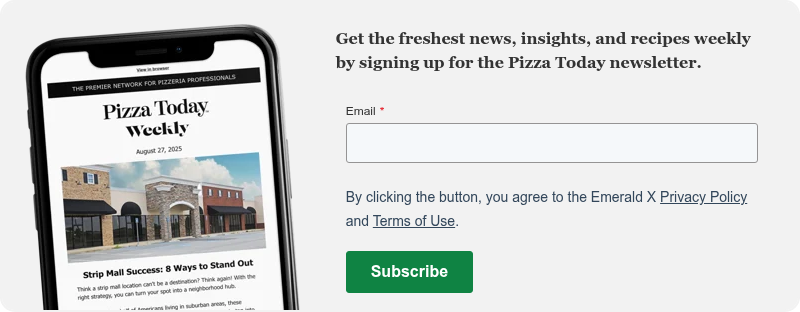Most pizzeria owners haven’t put as much thought into menu engineering as they have put into the food that comes out of the kitchen, according to Mike Bausch, owner of Andolini’s Pizzeria in Tulsa, Oklahoma.
The challenge to the many chef-driven operators is that a passion for food alone doesn’t pay the bills. Bausch should know. He says during Pizza Expo 2025 that he and his brother initially built the restaurant “purely on the love of the food.”
That all started to change when they had to borrow money from the bank because the operation was not as profitable as it could have been. The realization sent Bausch on a mission to master menu design. The message: Customers don’t need more choices; instead, pizzerias need a clear path to profit.
Why Your Unique Selling Point Matters
Before diving into the nuts and bolts of menu design, Bausch emphasizes the necessity of a signature item. “You don’t need to be unique to exist today. … You need to be unique to exist tomorrow.”
This unique selling point (USP) must be the star of the show – the item customers feel they must get when they visit. Using a premium ingredient doesn’t count as a USP if you don’t tell anyone about it.
Menu Layout Science
Once a strong signature item is established, the next step is placing it where it will have the most impact. Bausch calls the “golden triangle” a crucial piece of consumer psychology.
“Everyone goes to the top right when you look at a menu,” he says. “Subconsciously, you all do this.”
The typical scan path is:
- Top Right: Where the signature item should be, preferably in a box to draw even more attention.
- Top Left: Where the eyes move next, making it ideal for appetizers.
- Center: Where the rest of the main items are scanned.
“You are going to change your menu to match that if you want profit,” he says.
Bausch says his own signature item, The DeMarco of Brooklyn, appears in the top right corner of his menu.
Using Photos
The question of using photos on menus is a common one, and Bausch provides clear guidelines.
For Online Menus: Photography is mandatory. He recommends taking your own pictures in natural light and using portrait mode to avoid the inauthentic look of stock photos. “Don’t be inauthentic,” he stresses. At the same time, he cautions against being too real, like showing a fully cut pizza in a box. In this case, a little bit of styling goes a long way.
For In-House Menus: Tread carefully. Photos can give off an “IHOP” vibe, Bausch says, which might not align with an experience-driven brand. For high-end restaurants, an understated, text-only menu often conveys more class. For family-fun concepts, photos can work, but they must be done well to avoid a cluttered look.
Menu Pricing Psychology
How you display prices is as important as the prices themselves. Bausch breaks down the science behind pricing strategy. “$7.99 says … you’re lying. It’s really $8,” he explains. “$7.95? It’s far enough away, subconsciously. We do that dance.”
His top recommendation? Remove the dollar sign entirely. The “$” symbol immediately reminds customers they are spending money. By simply listing the number (e.g., “8”) – and, even better, making the font size smaller than the item description – the price becomes a footnote. The customer’s brain focuses on the desirable food item, not the cost, keeping them in a positive buying mindset.
When determining the actual price, Bausch outlines a three-step process:
- Food Cost: Start with your actual food cost to ensure profitability. Bausch stresses including waste and packaging in this calculation, but not labor.
- Comparative Price: See what competitors are charging for similar items to understand the market range.
- The Sizzle: “How much can I get when I add sizzle to it, when I add story, when I add showmanship?” This is where an operator can break free from market comparisons and command premium prices, just as Bausch does with his $32 DeMarco pizza.
Curating Your Offerings
More options do not equal more money. Bausch says his original menu from 22 years ago was a sprawling document with five pizza sizes and every sandwich imaginable. “If we can make it, let’s do it,” was his early, flawed philosophy. The result was operational complexity and diluted profits.
Today, he advocates for an “all killer, no filler” approach. For example, Bausch sees frozen, pre-made mozzarella sticks as a squandered opportunity. By slicing it into rounds, breading it and frying it, Bausch creates something unique and demonstrably superior.
Naming, Branding, and Building an Experience
The final pieces of the menu engineering puzzle involve branding and experience.
Name Theory
Bausch urges owners to move beyond generic names such as “Cheese Pizza.” Even a classic dish like eggplant parm can be elevated to “Salvatore’s Eggplant Parm.” He recommends choosing a theme for names – like New York streets or rock bands – and sticking to it for brand cohesion.
He also warns against having two different items with similar names, like “The Italian Deli Pizza” and “The Italian Deli Sandwich,” a mistake he admits to making himself early on and causing confusion.
Clarity is paramount. While an item’s name can be ornate, the description must be simple and easy to read. “Don’t be cute at the expense of obvious,” he advises.
Experience vs. Value
Ultimately, the menu is a tool to sell an experience, not just a product. Bausch argues that competing on value is a race to the bottom that independents can’t win against convenience stores and national chains.
“If you’re not impressive, by default, you’re unimpressive, and they’re not coming back,” he concludes. He practices this by making fresh mozzarella, Caesar salads and Fettuccine Alfredo tableside at his restaurants. These experiences justify a higher menu price, which leads to more profit.
Your Path to Profit
Finally, Bausch reminds operators that real change requires action. Your menu is a powerful tool to change your restaurant’s financial future. By applying principles of psychology and design, any operator can transform their menu from a simple list of items into a finely tuned engine for profit.



